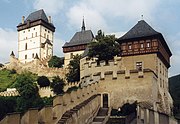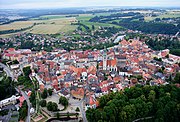Archaeologists have found evidence of prehistoric human settlements in the area, dating back to the Neolithic era. In the classical era, from the 3rd century BC Celtic migrations, the Boii (see Bohemia) and later in the 1st century, Germanic tribes of Marcomanni and Quadi settled there. During the Migration Period around the 5th century, many Germanic tribes moved westwards and southwards out of Central Europe. In an equally significant migration, Slavic peoples from the Black Sea and Carpathian regions settled in the area (a movement that was also stimulated by the onslaught of peoples from Siberia and Eastern Europe: Huns, Avars, Bulgars and Magyars). Following in the Germans' wake, they moved southwards into Bohemia, Moravia and some of present day Austria. During the 7th century, the Frankish merchant, Samo, supporting the Slavs fighting their Avar rulers, became the ruler of the first known Slav state in Central Europe. The Moravian principality arose in the 8th century (see Great Moravia).
The Bohemian or Czech state emerged in the late 9th century, when it was unified by the Přemyslid dynasty. The kingdom of Bohemia was a significant regional power during the Middle Ages. It was part of the Holy Roman Empire during the entire existence of that confederation.
In 1212, King Přemysl Otakar I (1198-1230), bearing the title “king“ already since 1198, extracted a Golden Bull of Sicily (a formal edict) from the emperor, confirming the royal title for Otakar and his descendants. The 13th century was also a period of large-scale German immigration. The Germans populated towns and mining districts on the Bohemian periphery and, in some cases, formed German colonies in the interior of the Czech lands. In 1241, the mighty Mongol army launched an invasion of Europe and after the Battle of Legnica, the Mongols carried their devastating raid into Moravia. King Přemysl Otakar II (1253–1278) earned the nickname of "the King of Gold and Iron" due to his military power and wealth. He met his death at the Battle on the Marchfeld in 1278, in a war with his rival, the Roman king Rudolph I of Germany. In 1306, the Přemyslid line died out and, after a series of dynastic wars, the House of Luxembourg gained the Bohemian crown. The 14th century, particularly the reign of Charles IV (1342-1378), is considered the Golden Age of Czech history. Of particular significance was the founding of Charles University in Prague in 1348. The Black Death, which had raged in Europe from 1347-1352, decimated the Kingdom of Bohemia in 1380.
In the 15th century the religious and social reformer Jan Hus formed a movement, later named after him. Although Hus was named a heretic and burnt in Constanz in 1415, his followers seceded from the Catholic Church and in the Hussite Wars (1419-1434) defeated five crusades organized against them by the Holy Roman Emperor Sigismund. During the next two centuries, 90% of the inhabitants converted to the Hussite form of Protestantism. After 1526 Bohemia came increasingly under Habsburg control as the Habsburgs became first the elected and then the hereditary rulers of Bohemia. The Defenestration of Prague and subsequent revolt against the Habsburgs in 1618 marked the start of the Thirty Years' War, which quickly spread throughout Germany. In 1620, the rebellion in Bohemia was crushed at the Battle of White Mountain and the country became a province of the Austrian monarchy. The war had a devastating effect on the local population; the people were given the choice either to convert to Catholicism or leave the country. Czechs call the following period, from 1620 to the late 18th century, the "Dark Age". The population of the Czech lands declined by a third due to war, disease, famine and the expulsion of the Protestant Czechs. The Habsburgs banned all religions other than Catholicism. Ottoman Turks and Tatars invaded Moravia in 1663, taking 12,000 slaves.
The reigns of Maria Theresa of Austria (1740-80) and her son Joseph II (1780-90), Holy Roman Emperor and co-regent from 1765, were characterized by enlightened absolutism. In 1742, most of Silesia, then the possession of the Bohemian crown, was seized by King Frederick II of Prussia in the War of the Austrian Succession. The Great Famine, which lasted from 1770 until 1771, killed 12% of the Czech population, up to 500,000 inhabitants, and radicalized countrysides leading to peasant uprisings. After the fall of the Holy Roman Empire, Bohemia became part of the Austrian Empire and later of Austria–Hungary. Serfdom was not completely abolished until 1848. After the Revolutions of 1848, Emperor Franz Josef I of Austria attempted to rule as an absolute monarch, keeping all the nationalities in check.
An estimated 150,000 Czech soldiers died in World War I. More than 100,000 Czech volunteers formed the Czechoslovak Legions in Russia, where they fought against the Central Powers and later against Bolshevik troops. Following the collapse of the Austro-Hungarian Empire after World War I, the independent republic of Czechoslovakia was created in 1918. This new country incorporated regions of Bohemia, Moravia, Silesia, Slovakia and the Carpathian Ruthenia (known as the Subcarpathian Rus at the time) with significant German, Hungarian, Polish and Ruthenian speaking minorities. Although Czechoslovakia was a unitary state, it provided what were at the time rather extensive rights to its minorities. However, it did not grant its minorities any territorial political autonomy. The failure to do so resulted in discontent and strong support among some of the minorities for a break from Czechoslovakia. Adolf Hitler took advantage of this opportunity and, supported by Konrad Henlein's Sudeten German Party, gained the largely German speaking Sudetenland (and its substantial Maginot Line like border fortifications), through the 1938 Munich Agreement. Poland annexed the Zaolzie area around Český Těšín. Hungary gained parts of Slovakia and the Subcarpathian Rus as a result of the First Vienna Award in November 1938.
The remainders of Slovakia and the Subcarpathian Rus gained greater autonomy, with the state renamed to "Czecho-Slovakia" (The Second Republic; see German occupation of Czechoslovakia). After Nazi Germany threatened to annex part of Slovakia, allowing the remaining regions to be partitioned by Hungary and Poland, Slovakia chose to maintain its national and territorial integrity, seceding from Czecho-Slovakia in March 1939 and allying itself, as demanded by Germany, with Hitler's coalition. The remaining Czech territory was occupied by Germany, which transformed it into the so-called Protectorate of Bohemia and Moravia. The Protectorate was proclaimed part of the Third Reich and the President and Prime Minister were subordinate to the Nazi Reichsprotektor ("imperial protector"). Subcarpathian Rus declared independence as the Republic of Carpatho-Ukraine on 15 March 1939, but was invaded by Hungary the same day and formally annexed the next day. Approximately 390,000 Czechoslovak citizens, including 83,000 Jews, were killed or executed, while hundreds of thousands of others were sent to prisons and concentration camps or used as forced labour. A Nazi concentration camp existed at Terezín, to the north of Prague. There was Czech resistance to Nazi occupation, both at home and abroad, most notably with the assassination of Nazi leader Reinhard Heydrich in a Prague suburb on May 27, 1942. The Czechoslovak government-in-exile and its army fighting against the Germans were acknowledged by the Allies; Czechoslovak troops fought in the United Kingdom, North Africa, the Middle East and the Soviet Union. The German occupation ended on 9 May 1945, with the arrival of the Soviet and American armies and the Prague uprising.
In 1945-1946, almost the entire German minority in Czechoslovakia, about 2.7 million people, were expelled to Germany and Austria. During this time, thousands of Germans were held in prisons and detention camps, or used as forced labour. In the summer of 1945, there were several massacres. The only Germans not expelled were some 250,000, who had been active in the resistance against the Nazis or were considered economically important, though many of these emigrated later. Following a Soviet-organised referendum, the Subcarpathian Rus never returned under Czechoslovak rule, but became part of the Ukrainian Soviet Socialist Republic, as the Zakarpattia Oblast in 1946.
Czechoslovakia uneasily tried to play the role of a "bridge" between the West and East. However, the Communist Party of Czechoslovakia rapidly increased in popularity, with a general disillusionment with the West, due to the pre-war Munich Agreement, and a favourable popular attitude towards the Soviet Union, due to the Soviets' role in liberating Czechoslovakia from German rule. In the 1946 elections, the Communists gained 38% of the votes and became the largest party in the Czechoslovak parliament. They formed a coalition government with other parties of the National Front and moved quickly to consolidate power. The decisive step took place in February 1948, during a series of events characterized by Communists as a "revolution" and by anti-Communists as a "takeover", the Communist People's Militias secured control of key locations in Prague, and a new, all-Communist government was formed.
For the next 41 years, Czechoslovakia was a Communist state within the Eastern Bloc (see History of Czechoslovakia (1948–1989)). This period was marked by a variety of social developments. The Communist government completely nationalized the means of production and established a command economy. The economy grew rapidly during the 1950s and 1960s, but slowed down in the 1970s, with increasing problems during the 1980s. The political climate was highly repressive during the 1950s, including numerous show trials, but became more open and tolerant in the 1960s, culminating in Alexander Dubček's leadership in the 1968 Prague Spring, which tried to create "socialism with a human face" and perhaps even introduce political pluralism. This was forcibly ended by the 21 August 1968 Warsaw Pact invasion.
The invasion was followed by a harsh program of "Normalization" in the late 1960s and the 1970s. Until 1989, the political establishment relied on censorship of the opposition, though using more "carrot" than "whip" to secure the populace's passivity. Dissidents published Charter 77 in 1977 and the first of a new wave of protests were seen in 1988.
In November 1989, Czechoslovakia returned to a liberal democracy through the peaceful "Velvet Revolution". However, Slovak national aspirations strengthened and on January 1, 1993, the country peacefully split into the independent Czech Republic and Slovakia. Both countries went through economic reforms and privatizations, with the intention of creating a capitalist economy.
Due to deficiencies with the Soviet-style economy, voters embraced the neoliberal model of economics, friendly to globalization objectives favored by Western elites. This enabled the Czech Republic to become the first post-communist country to receive an investment-grade rating from international credit rating agencies. Most state-owned heavy industries were privatized through voucher privatization systems, that essentially sold such assets to private concerns for a fraction of their actual value. The Czech Republic saw for a while modest budget deficits, low unemployment, a positive balance of payments, a stable exchange rate and a shift of exports from former communist economic bloc markets to Western Europe. This has changed over the past decade (see below). The most important change, since 1989, has been the return of the right to own property.
From 1991, the Czech Republic, originally as part of Czechoslovakia and now in its own right, has been a member of the Visegrád Group and from 1995, the OECD. The Czech Republic joined NATO on March 12, 1999 and the European Union on May 1, 2004.
